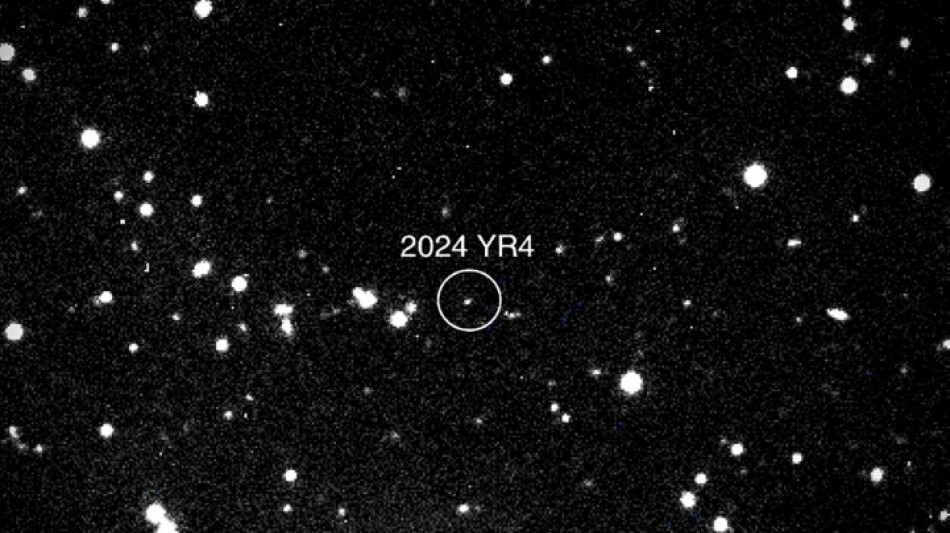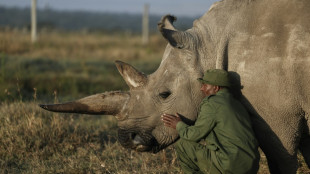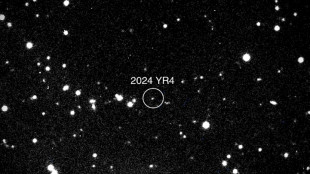
-
 Spotify adds more AI-generated audiobooks
Spotify adds more AI-generated audiobooks
-
Stocks in the red as investors worry about growth and inflation

-
 Bond franchise shifts to Amazon as Broccoli family steps back
Bond franchise shifts to Amazon as Broccoli family steps back
-
Unfair? Figures belie Trump's claims on EU trade balance

-
 Stock markets mostly lower on Fed concerns over Trump policies
Stock markets mostly lower on Fed concerns over Trump policies
-
France moves to ban marriage for undocumented migrants

-
 Walmart sales rise but shares tumble on forecast
Walmart sales rise but shares tumble on forecast
-
Spain court convicts ex-football chief for sexual assualt over forced kiss

-
 Mercedes-Benz flags cost cuts, tough year ahead after torrid 2024
Mercedes-Benz flags cost cuts, tough year ahead after torrid 2024
-
ECB rate hikes result in record loss in 2024

-
 Romanian director Jude shoots latest film in 10 days on an iPhone
Romanian director Jude shoots latest film in 10 days on an iPhone
-
Sri Lanka passenger train kills six elephants

-
 Stock markets mixed on Fed concern over Trump policies
Stock markets mixed on Fed concern over Trump policies
-
Birkenstock sandals are not art, German court rules

-
 Markets drop, gold hits record on Fed concern over Trump policies
Markets drop, gold hits record on Fed concern over Trump policies
-
Airbus profit climbs in 2024, aims to accelerate output

-
 Airbus proft climbs in 2024, aims to accelerate output
Airbus proft climbs in 2024, aims to accelerate output
-
Trump says trade deal with China 'possible'

-
 Northern Japan snowed under after two-week whiteout
Northern Japan snowed under after two-week whiteout
-
Mercedes-Benz profits plunge as German carmakers reel

-
 'We will save them': The quest to rescue nearly extinct rhino
'We will save them': The quest to rescue nearly extinct rhino
-
Berlin film festival nurtures portraits of messy motherhood

-
 Renault revs up profitability in 2024
Renault revs up profitability in 2024
-
Japan's trade minister arranging US trip: reports

-
 Eyeing China and US, EU hopes clean tech boost will spark growth
Eyeing China and US, EU hopes clean tech boost will spark growth
-
Trump considering 'alternatives' to Boeing for Air Force One contract

-
 Afghanistan problem 'can be solved': former women's affairs minister
Afghanistan problem 'can be solved': former women's affairs minister
-
Lights out for Indonesia civil servants as Prabowo cuts budgets

-
 London Fashion Week launches with ode to gender fluid designs
London Fashion Week launches with ode to gender fluid designs
-
Asian markets drop as Fed flags concern over Trump policies

-
 Heated immigration debate complicates Germany's search for workers
Heated immigration debate complicates Germany's search for workers
-
Australia seeks to turn failing steel plant into 'green' hub

-
 Conservative Merz leads Germany's turbulent election race
Conservative Merz leads Germany's turbulent election race
-
After rocky road, Havana's 'Cathedral of Ice Cream' back in from the cold

-
 Hezbollah readies massive funeral for slain leader Nasrallah
Hezbollah readies massive funeral for slain leader Nasrallah
-
Indonesia industrial coal power plans undercut emissions pledge: report

-
 Reach Secures Major Investment to Accelerate Its Global Expansion and Fuel Enterprise Merchant Growth
Reach Secures Major Investment to Accelerate Its Global Expansion and Fuel Enterprise Merchant Growth
-
Trump moves to end New York congestion pricing, sparking legal challenge

-
 Stock markets pressured by Trump auto tariff threat
Stock markets pressured by Trump auto tariff threat
-
Trump's labor nominee walks back pro-union stances

-
 Apple adds lower-price iPhone 16e to line-up
Apple adds lower-price iPhone 16e to line-up
-
Ikea hopes for furniture market improvement in 2026

-
 Game, set, hate: WTA stars reveal fears after Raducanu's Dubai shock
Game, set, hate: WTA stars reveal fears after Raducanu's Dubai shock
-
Tajikistan to publish new dress 'guidelines' for women

-
 Stock markets skid after Trump threatens auto tariffs
Stock markets skid after Trump threatens auto tariffs
-
Glencore looks to leave London Stock Exchange as falls into loss

-
 Stock markets fall as traders assess latest tariffs volley
Stock markets fall as traders assess latest tariffs volley
-
Poll gives Zelensky 57% approval rating despite Trump claims

-
 BAE profits boosted by defence spending amid Ukraine war
BAE profits boosted by defence spending amid Ukraine war
-
Asset writedowns push Glencore into $1.6 bn loss for 2024


'City killer' asteroid now has 3.1% chance of hitting Earth: NASA
An asteroid that could level a city now has a 3.1 percent chance of striking Earth in 2032, according to NASA data released Tuesday -- making it the most threatening space rock ever recorded by modern forecasting.
Despite the rising odds, experts say there's no need for alarm. The global astronomical community is closely monitoring the situation and the James Webb Space Telescope is set to fix its gaze on the object, known as 2024 YR4, next month.
"I'm not panicking," Bruce Betts, chief scientist for the nonprofit Planetary Society told AFP.
"Naturally when you see the percentages go up, it doesn't make you feel warm and fuzzy and good," he added, but explained that as astronomers gather more data, the probability will likely edge up before rapidly dropping to zero.
2024 YR4 was first detected on December 27 last year by the El Sauce Observatory in Chile.
Astronomers estimate its size to be 130 to 300 feet (40–90 meters) wide, based on its brightness. Analysis of its light signatures suggests it has a fairly typical composition, rather than being a rare metal-rich asteroid.
The International Asteroid Warning Network (IAWN), a worldwide planetary defense collaboration, issued a warning memo on January 29 after the impact probability had crossed one percent. Since then, the figure has fluctuated but continues to trend upward.
NASA's latest calculations estimate the impact probability at 3.1 percent, with a potential Earth impact date of December 22, 2032.
That translates to odds of one in 32 -- roughly the same as correctly guessing the outcome of five consecutive coin tosses.
The last time an asteroid of greater than 30 meters in size posed such a significant risk was Apophis in 2004, when it briefly had a 2.7 percent chance of striking Earth in 2029 -- a possibility later ruled out by additional observations.
Surpassing that threshold is "historic," said Richard Moissl, head of the European Space Agency's planetary defense office, which puts the risk slightly lower at 2.8 percent.
- Webb observations in March -
"It's a very, very rare event," he told AFP, but added: "This is not a crisis at this point in time. This is not the dinosaur killer. This is not the planet killer. This is at most dangerous for a city."
Data from the Webb telescope -- the most powerful space observatory -- will be key in better understanding its trajectory, said the Planetary Society's Betts.
"Webb is able to see things that are very, very dim," he said -- which is key because the asteroid's orbit is currently taking it out towards Jupiter, and its next close approach won't be until 2028.
Unlike the six-mile-wide (10-kilometer-wide) asteroid that wiped out the dinosaurs 66 million years ago, 2024 YR4 is classified as a "city killer" -- not a global catastrophe, but still capable of causing significant destruction.
Its potential devastation comes less from its size and more from its velocity, which could be nearly 40,000 miles per hour if it hits.
If it enters Earth's atmosphere, the most likely scenario is an airburst, meaning it would explode midair with a force of approximately eight megatons of TNT -- more than 500 times the power of the Hiroshima bomb.
But an impact crater can't be ruled out if the size is closer to the higher end of estimates, said Betts.
If it does hit, possible impact sites include over the eastern Pacific Ocean, northern South America, the Atlantic Ocean, Africa, the Arabian Sea, and South Asia, the IAWN memo states.
The good news, experts emphasize, is that there is ample time to prepare. If necessary, spacecraft could be sent to deflect the asteroid -- technology that was successfully demonstrated in NASA's 2022 DART mission, which altered the course of a non-threatening asteroid.
Y.Jeong--CPN

